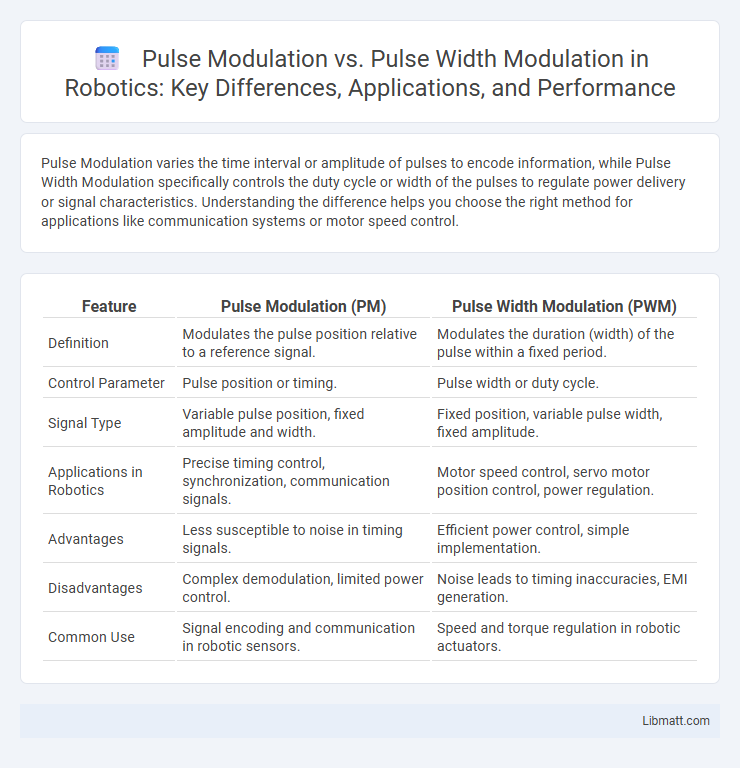Pulse Modulation varies the time interval or amplitude of pulses to encode information, while Pulse Width Modulation specifically controls the duty cycle or width of the pulses to regulate power delivery or signal characteristics. Understanding the difference helps you choose the right method for applications like communication systems or motor speed control.
Table of Comparison
| Feature | Pulse Modulation (PM) | Pulse Width Modulation (PWM) |
|---|---|---|
| Definition | Modulates the pulse position relative to a reference signal. | Modulates the duration (width) of the pulse within a fixed period. |
| Control Parameter | Pulse position or timing. | Pulse width or duty cycle. |
| Signal Type | Variable pulse position, fixed amplitude and width. | Fixed position, variable pulse width, fixed amplitude. |
| Applications in Robotics | Precise timing control, synchronization, communication signals. | Motor speed control, servo motor position control, power regulation. |
| Advantages | Less susceptible to noise in timing signals. | Efficient power control, simple implementation. |
| Disadvantages | Complex demodulation, limited power control. | Noise leads to timing inaccuracies, EMI generation. |
| Common Use | Signal encoding and communication in robotic sensors. | Speed and torque regulation in robotic actuators. |
Introduction to Pulse Modulation
Pulse modulation is a technique used in signal processing to encode information into pulses for transmission or processing. It includes various methods such as Pulse Width Modulation (PWM), Pulse Amplitude Modulation (PAM), and Pulse Position Modulation (PPM), each varying the pulse characteristics to represent data. Understanding pulse modulation is essential for improving communication system efficiency and adapting signals for different transmission mediums.
Understanding Pulse Width Modulation (PWM)
Pulse Width Modulation (PWM) controls the amount of power delivered to an electrical device by varying the width of the pulses in a pulse train, effectively adjusting the average voltage supplied. Unlike general pulse modulation, PWM maintains a constant frequency while changing the duty cycle, allowing precise control over motor speed, LED brightness, and signal processing. Understanding PWM helps you achieve efficient energy use and fine-tuned control in various electronic applications.
Core Principles of Pulse Modulation
Pulse Modulation involves encoding information in the timing or amplitude of pulses, creating a discrete signal representation of an analog waveform. Pulse Width Modulation (PWM) specifically varies the duration of each pulse within a fixed frequency to control power delivery or signal strength efficiently. Understanding these core principles allows you to select the appropriate modulation technique for precise control in communication and power electronics applications.
Key Differences Between Pulse Modulation and PWM
Pulse Modulation involves varying the position or frequency of pulses to encode information, while Pulse Width Modulation (PWM) specifically controls the duration or width of pulses to adjust power delivery. PWM offers more precise control over voltage and current in electronic devices by altering the pulse duty cycle, making it ideal for motor speed control and LED dimming. Understanding these key differences helps you select the right modulation technique for efficient signal processing and power management in your applications.
Applications of Pulse Modulation
Pulse modulation finds extensive applications in telecommunications for encoding analog signals into digital formats, enhancing signal integrity over long distances. It is widely used in radar systems to control pulse timing and improve target detection accuracy. Pulse width modulation (PWM) is predominantly utilized in motor control, power regulation, and audio signal processing due to its efficiency in managing voltage and current delivery.
PWM: Applications and Use Cases
Pulse Width Modulation (PWM) is extensively used in applications requiring efficient control of power delivery, such as motor speed regulation, LED dimming, and voltage control in power supplies. Its ability to precisely vary the duty cycle allows for fine-tuned adjustments in devices like servo motors, heating elements, and audio signal modulation. You can leverage PWM in embedded systems and IoT devices to optimize energy consumption and enhance performance in real-time control scenarios.
Advantages and Limitations of Pulse Modulation
Pulse Modulation offers advantages such as improved noise immunity and efficient signal transmission over long distances, making it ideal for digital communication systems. However, its limitations include increased bandwidth requirements and complexity in implementation compared to simpler modulation schemes. Understanding these trade-offs helps you choose the right modulation technique for your specific application needs.
Benefits and Drawbacks of Pulse Width Modulation
Pulse Width Modulation (PWM) offers precise control of power delivery by varying the duty cycle of a fixed frequency signal, enhancing energy efficiency in applications like motor speed control and LED dimming. Its benefits include reduced heat dissipation and improved signal fidelity compared to simple Pulse Modulation, which varies pulse frequency or amplitude. Drawbacks of PWM involve electromagnetic interference and potential signal distortion at high switching frequencies, requiring careful filter design and component selection.
Choosing the Right Modulation Technique
Choosing the right modulation technique depends on the specific application requirements such as signal fidelity, power efficiency, and noise tolerance. Pulse Modulation (PM) offers simpler implementation and is suited for transmitting analog signals with reduced bandwidth, while Pulse Width Modulation (PWM) excels in controlling power delivery and motor speed with high precision. Engineers often select PWM in power electronics and motor control due to its superior efficiency, whereas PM is preferred in communication systems where bandwidth conservation is critical.
Future Trends in Modulation Technologies
Emerging trends in modulation technologies emphasize increased efficiency and precision, with Pulse Width Modulation (PWM) gaining prominence due to its superior energy control in applications like renewable energy systems and electric vehicles. Advanced Pulse Modulation techniques are being integrated with digital signal processing to enhance communication bandwidth and reduce noise interference. Your choice of modulation method can significantly impact the performance of future electronic and communication devices as innovation pushes toward smarter and more adaptive systems.
Pulse Modulation vs Pulse Width Modulation Infographic

 libmatt.com
libmatt.com